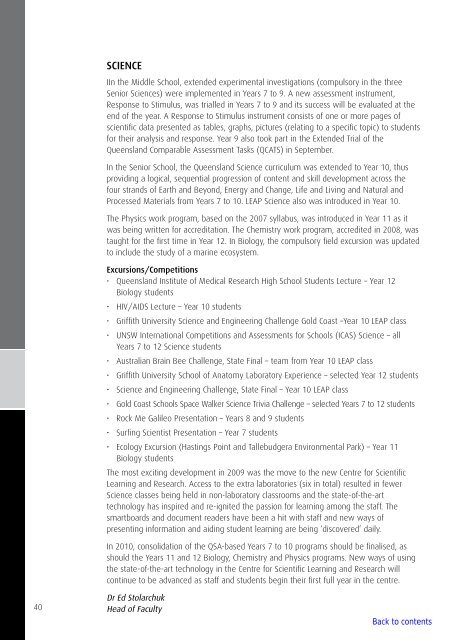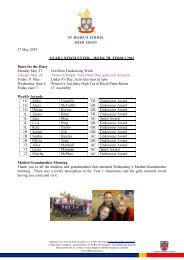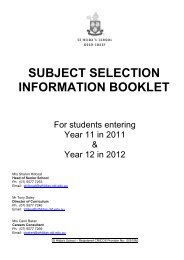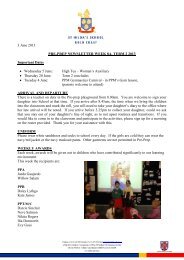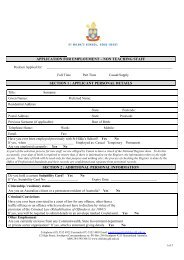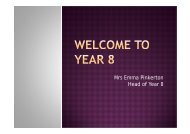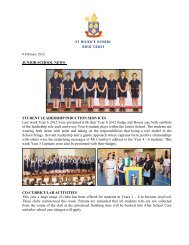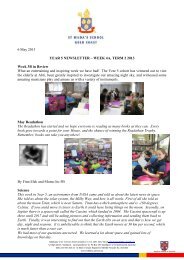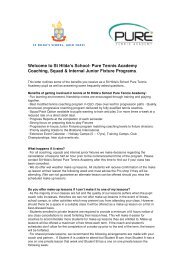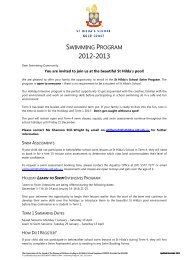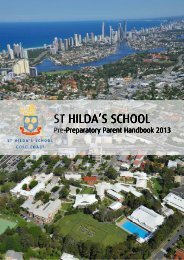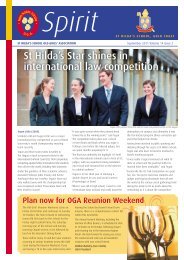THE HEAD OF SCHOOL'S ANNUAL REPORT 2009 - St Hildas School
THE HEAD OF SCHOOL'S ANNUAL REPORT 2009 - St Hildas School
THE HEAD OF SCHOOL'S ANNUAL REPORT 2009 - St Hildas School
You also want an ePaper? Increase the reach of your titles
YUMPU automatically turns print PDFs into web optimized ePapers that Google loves.
SCIENCE<br />
IIn the Middle <strong>School</strong>, extended experimental investigations (compulsory in the three<br />
Senior Sciences) were implemented in Years 7 to 9. A new assessment instrument,<br />
Response to <strong>St</strong>imulus, was trialled in Years 7 to 9 and its success will be evaluated at the<br />
end of the year. A Response to <strong>St</strong>imulus instrument consists of one or more pages of<br />
scientific data presented as tables, graphs, pictures (relating to a specific topic) to students<br />
for their analysis and response. Year 9 also took part in the Extended Trial of the<br />
Queensland Comparable Assessment Tasks (QCATS) in September.<br />
In the Senior <strong>School</strong>, the Queensland Science curriculum was extended to Year 10, thus<br />
providing a logical, sequential progression of content and skill development across the<br />
four strands of Earth and Beyond, Energy and Change, Life and Living and Natural and<br />
Processed Materials from Years 7 to 10. LEAP Science also was introduced in Year 10.<br />
The Physics work program, based on the 2007 syllabus, was introduced in Year 11 as it<br />
was being written for accreditation. The Chemistry work program, accredited in 2008, was<br />
taught for the first time in Year 12. In Biology, the compulsory field excursion was updated<br />
to include the study of a marine ecosystem.<br />
Excursions/Competitions<br />
• Queensland Institute of Medical Research High <strong>School</strong> <strong>St</strong>udents Lecture – Year 12<br />
Biology students<br />
• HIV/AIDS Lecture – Year 10 students<br />
• Griffith University Science and Engineering Challenge Gold Coast –Year 10 LEAP class<br />
• UNSW International Competitions and Assessments for <strong>School</strong>s (ICAS) Science – all<br />
Years 7 to 12 Science students<br />
• Australian Brain Bee Challenge, <strong>St</strong>ate Final – team from Year 10 LEAP class<br />
• Griffith University <strong>School</strong> of Anatomy Laboratory Experience – selected Year 12 students<br />
• Science and Engineering Challenge, <strong>St</strong>ate Final – Year 10 LEAP class<br />
• Gold Coast <strong>School</strong>s Space Walker Science Trivia Challenge – selected Years 7 to 12 students<br />
• Rock Me Galileo Presentation – Years 8 and 9 students<br />
• Surfing Scientist Presentation – Year 7 students<br />
• Ecology Excursion (Hastings Point and Tallebudgera Environmental Park) – Year 11<br />
Biology students<br />
The most exciting development in <strong>2009</strong> was the move to the new Centre for Scientific<br />
Learning and Research. Access to the extra laboratories (six in total) resulted in fewer<br />
Science classes being held in non-laboratory classrooms and the state-of-the-art<br />
technology has inspired and re-ignited the passion for learning among the staff. The<br />
smartboards and document readers have been a hit with staff and new ways of<br />
presenting information and aiding student learning are being ‘discovered’ daily.<br />
In 2010, consolidation of the QSA-based Years 7 to 10 programs should be finalised, as<br />
should the Years 11 and 12 Biology, Chemistry and Physics programs. New ways of using<br />
the state-of-the-art technology in the Centre for Scientific Learning and Research will<br />
continue to be advanced as staff and students begin their first full year in the centre.<br />
40<br />
Dr Ed <strong>St</strong>olarchuk<br />
Head of Faculty


